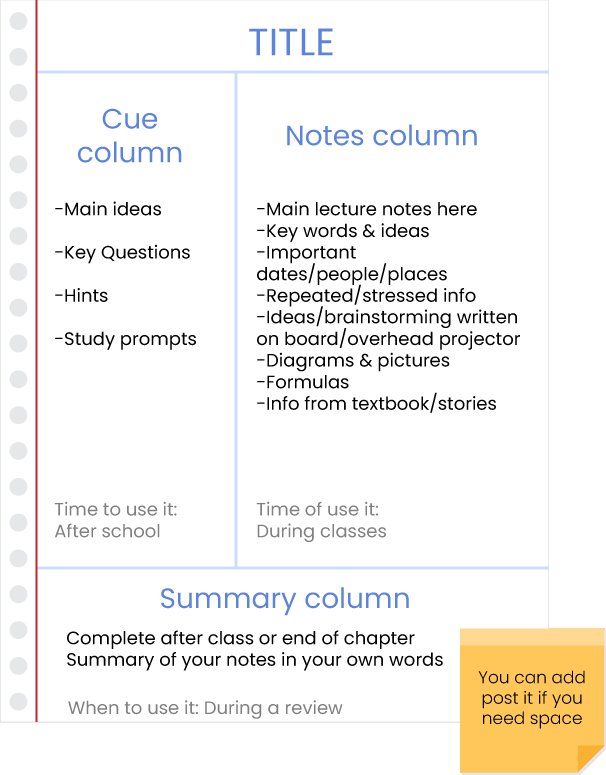Cornell Method - The best technique for taking notes
Discover the best method to take notes and optimize your learning. We tell you the step-by-step and we give you the definitive template so that you can increase your productivity and educational performance to 100%.

Taking notes correctly is very important when studying. Through the Cornell method, you will learn to keep your notes organized and well structured, achieving better results when studying.
What is the Cornell Method?
The Cornell Notes Method is a note-taking system created by Walter Pauk in the 1950s. This system consists of using a format as a basis for organizing information, presenting it, and making it easier to read later.
This method can be used in school during class, when doing research, or when studying a book, being a very effective technique.
What is the Cornell method for?
The purpose of the Cornell method is to allow those who use it to analyze the data they record in their notebooks more easily. This is because the information will be organized and narrated in the person's own words, making it easier to memorize.
This last point is particularly useful when carrying out an investigation since it allows separating the ideas that are the user's own from those that belong to another author.
By having a more efficient and organized note system, the student will be able to understand and retain the information reflected in them more easily. In this way, the Cornell method promotes much more efficient and productive study sessions.
How does the Cornell method work?
This study method is very simple since you only need a pencil and a sheet of paper. To start, you need to divide the sheet into four areas, where you will place a different type of content in each one. You must complete each area during class, taking notes and extracting the most important information.
Here's how to divide the sheet and what each section should contain:

The header (top horizontal margin)
In this section, you must write: Title, name of the course, date, and page number (key to maintain order).
Cue column (Left Margin)
This section is used to record key questions about the class or text, important points and concepts, unanswered questions, and simple diagrams.
Ideally, you should use this section as a topic review on the same day you took your notes.
Notes column (leading space/right margin)
In this area you should place the notes you take during the class or the reading of the book. It serves to write all the information that you consider relevant, such as important phrases, references, lists, diagrams, formulas, notes on the board, examples, concepts, etc.
Summary column (bottom horizontal margin)
This section is for you to make a brief summary where you synthesize all the content seen during the class, in order to have an overview of the most important points of the topic.
Tips for getting the most out of your notes
- Avoid using very long sentences.
- You can use symbols or abbreviations
- Review all the material after the class and write in the left column the relevant questions or key ideas so that you can then make a brief summary in the summary area.
- When you study, you can cover the right column while trying to answer the questions/key ideas in the left column. This technique is very useful when studying to learn and memorize the content.
- Within 24 hours after the class, complete the Summary area, reviewing the notes and reflecting on the topic seen. This synthesis will be of great help when studying and reviewing the content.
- Do not waste time rereading the note and completing the sections, because the sooner you do it, the fresher the topics will be, you will be able to better extract the main ideas and write down any doubts that have arisen.
5 R's of note-taking using the Cornell method
To guarantee better results, we recommend applying the Cornell method in conjunction with the 5 “R” technique.
This technique consists of performing 5 steps that will help you improve the understanding and memorization of all the information seen.
The 5 steps are:
-Record
In the notes column, record as many significant ideas, data, facts, and important points as you can during class. Write it down legibly and clearly, making sure you can later piece together the full idea.
-Reduce
After the class, make a summary of the topic seen in the Summary section, using short phrases and keywords. By summarizing, you clarify and fix what you learned on the day, establishing continuity and consolidating memorization.
-Recite
After class, cover the notes column and recite the topic learned out loud in your own words, guided by the key ideas in the left column.
-Reflect
After reciting, you should reflect and ask yourself questions about the topic seen and try to solve them.
-Review
Review your notes for at least 10 minutes each day to better retain the content and be more productive when studying for the test.
When to use the Cornell method?
You can use the method for any subject or book and at any time you want. Remember that it is not necessary to use any extra material to apply it, you only need a sheet of paper and a pencil.
Advantages of the Cornell Method
The Cornell method is one of the study techniques that has had the greatest impact in the academic world due to the advantages it offers. Some of them are:
1. Writing by hand helps us retain information better because it slows us down and we have to think about what we are writing.
2. Increases concentration and helps you stay focused during class, increasing your productivity during study hours.
3. It is about active listening
To take notes, you must not only concentrate but also carry out an active listening during the process, forcing yourself to assimilate the information, recognize the most important ideas and identify what we understand and what we do not.
3. This method will help you structure and order the content, giving you a framework for you to understand, review and learn it.
4. It can be used in any area of study, regardless of difficulty or situation, thus being very versatile.
5. It allows the development of other skills, such as organization or active listening, which are essential in the world of work.
You can take our Career Guidance Test for free by clicking below
What's Your Reaction?


















